
The Barelvi movement, also known as Ahl al-Sunnah wa'l-Jamaah is a Sunni revivalist movement following the Hanafi and Shafi'i schools of jurisprudence, and Maturidi and Ashʿari schools of theology with strong Sufi influences and with over hundreds of millions of followers in South Asia and also in parts of Europe, America and Africa. It is a broad Sufi-oriented movement that encompasses a variety of Sufi orders, including the Chistis, Qadiris, Soharwardis and Naqshbandis as well as many other orders and sub-orders of Sufism. They consider themselves to be the continuation of Sunni Islamic orthodoxy before the rise of Salafism and Deobandi Movement.

The National Mosque of Malaysia is a mosque in Kuala Lumpur, Malaysia. It has a capacity for 15,000 people and is situated among 13 acres (53,000 m2) of gardens. Its key features are a 73-metre-high (240 ft) minaret and a 16-pointed star concrete main roof. The umbrella, synonymous with the tropics, is featured conspicuously – the main roof is reminiscent of an open umbrella, the minaret's cap a folded one. The folded plates of the concrete main roof are a creative solution to achieving the larger spans required in the main gathering hall. Reflecting pools and fountains spread throughout the compound. Completed in 1965, the mosque is a bold and modern approach in reinforced concrete, symbolic of the aspirations of a then newly independent nation.
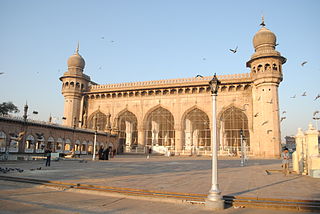
Makkah Masjid or Mecca Masjid, is a congregational mosque in Hyderabad, India. It is one of the largest mosques in India with a capacity of 10,000 people. The mosque was built during the 17th century, and is a state-protected monument. It serves as the primary mosque for the Old City of Hyderabad, and is located close to the historic landmarks of Charminar, Chowmahalla Palace and Laad Bazaar.
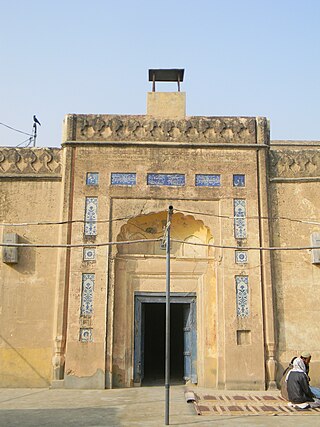
Mankera, is the principal town of Mankera Tehsil, an administrative subdivision of Bhakkar District, in the Punjab province of Pakistan. It is situated about 320 km (200 mi) west of the city of Lahore.

The Abidin Mosque is Terengganu's old state royal mosque built by Sultan Zainal Abidin II between 1793 and 1808. The mosque, which is also known as the White Mosque or the Big Mosque, is located in Kuala Terengganu, Terengganu, Malaysia. The old Royal Mausoleum is situated near the mosque.

Sahowala is a town in Sambrial Tehsil, Sialkot District, Punjab, Pakistan. It is located between the Upper Chenab Canal and the Marala Ravi Link Canal of the Marala Headworks project. Demographically, the town has a Union Council which is one of the largest councils in Sialkot, having a population around 20,000 which covers six neighbouring villages. Many residents are farmers, while others work abroad and serve in the industry and government. There is a big center of Tehreek Labaik Pakistan. The town is close to the Sialkot Tanneries Zone. Minhaj ul Quran Islamic Library is the public library, along Noor Mosque, which has the highest minaret in the Sialkot District. First Market and shopping center constructed at main Sahowala Road near Noor Mosque named DEEN CENTER since 2021. This village has a history of more than 800 years. Mughal Colony was also established in Sahowala.
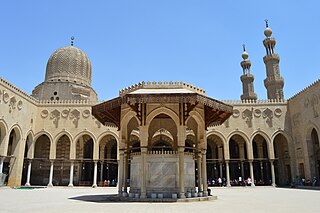
The Mosque of Sultan al-Mu'ayyad is a Mosque in Cairo, Egypt next to Bab Zuwayla built under the rule of sultan Al-Mu'ayyad Sayf ad-Din Shaykh from whom it takes its name, "Al-Mu'ayyad", meaning The Supporter in Arabic language. Construction began in 1415 and the mosque was completed in 1421. The complex included a Friday mosque and a madrasa for four madhhabs. It replaced a prison which originally stood next to Bab Zuwayla.

Khwaja Muhammad Tahir Bakhshi Naqshbandi, born 1963), also known as Sajjan Saeen, is a prominent Naqshbandi Sufi shaykh in Pakistan. He was born on March 21, 1963, at dargah Rahmatpur Sharif, district Larkana, Pakistan. He is successor to Khwaja Allah Bakhsh Rah, also known as Sohna Saeen, whose lineage goes to Khwaja Ghareeb Nawaz Fazal Ali Shah Qureshi. His followers and partisans are all over Pakistan and in countries such as the United Kingdom, Germany, Sweden, Spain, Australia, New Zealand, Sri Lanka, UAE, Canada and USA.
Dheedwal is a town 17 kilometers from Chakwal in Punjab, Pakistan. It has a hospital, a college, a bank, a utility store and some other services like telephone, cable and also water and gas supply.
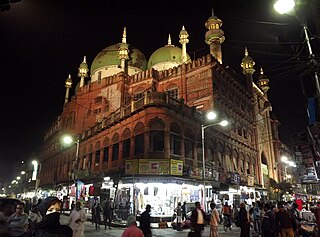
The Nakhoda Musjid is the principal mosque of Kolkata, India, in the Chitpur area of the Burrabazar business district in Central Kolkata, at the intersection of Zakaria Street and Rabindra Sarani.

The Bibi-Heybat Mosque is a historical mosque in Baku, Azerbaijan. The existing structure, built in the 1990s, is a recreation of the mosque with the same name built in the 13th century by Shirvanshah Farrukhzad II Ibn Ahsitan II, which was completely destroyed by the Bolsheviks in 1936.
Behak Mekan is a small town located in the Sargodha District ضلع سرگودھا of the Punjab province, Pakistan, that was formed when the area was part of the British Empire. The town is placed 16.5 kilometres (10.3 mi) away from the city of Sargodha and 10 kilometres (6.2 mi) away from Dhreema. Due to the town's ecological site, the British Royal Air Force (RAF) built an airstrip near "godhay wala" that become of great significance to the Pakistan Air Force after the Pakistan Movement independence of Pakistan.
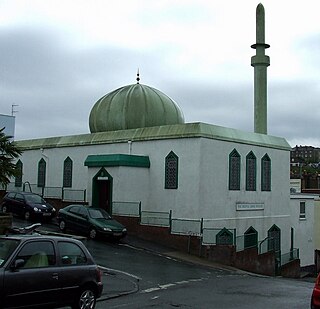
The Bristol Jamia Mosque is a mosque in the Totterdown area of Bristol. It was the first mosque in Bristol and is currently the largest in the south west of England. The building was formerly a disused church that was bought and converted into a mosque in 1968. It has since been embellished with a dome and minaret.

Jamia Mosque , also known as Grand mosque of Harar is a mosque in Harar, a city in eastern Ethiopia. It is located in the old walled city, the Harar Jugol, which is a UNESCO World Heritage Site.

Grand Jamia Mosque Lahore is a mosque located in Bahria Town, Lahore, Pakistan. With a capacity of 70,000 worshippers, it is the third largest mosque in Pakistan and the fourteenth largest mosque in the world.

Masjid-i-Ala is a mosque located inside the Srirangapatna Fort in Srirangapatna in Mandya District in Karnataka. It was built in 1786-87, during the rule of Tipu Sultan.

Jami Mosque of Taluak is one of the oldest mosques in Indonesia, located in Taluak IV Suku Nagari, Banuhampu District, Agam Regency, West Sumatra. The location of the mosque is close to the border of Bukittinggi, thus it is also known as Jamik Taluak Mosque Bukittinggi.

Jamek Mosque, officially Sultan Abdul Samad Jamek Mosque is one of the oldest mosques in Kuala Lumpur, Malaysia. It is located at the confluence of the Klang and Gombak River and may be accessed via Jalan Tun Perak. The mosque was designed by Arthur Benison Hubback, and built in 1909.
Sulṭān Zauq Nadvī is a Bangladeshi Islamic scholar, author and the founder of Jamia Darul Ma'arif Al-Islamia. He is known mainly for his expertise in and contribution to Arabic language and literature.
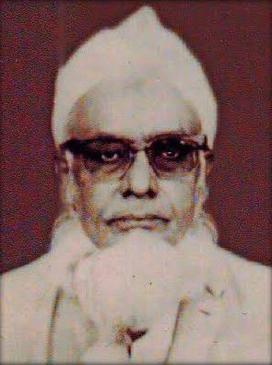
Muhammad Yunus Choudhury, popularly known as Haji Muhammad Yunus, was a Bangladeshi Islamic scholar and educationist. He was the second rector of Al Jamia Al Islamia Patiya, former president of Idarat al-Maʿarif and an active member of the Muslim World League. As the founding president of Befaqul Madarisil Arabia Bangladesh, Yunus contributed to the establishment and renovation of roughly 1500 madrasas in Bangladesh. He was awarded the title of Shaykh al-ʿArab wa al-ʿAjam by the Imam of Masjid al-Haram.

















